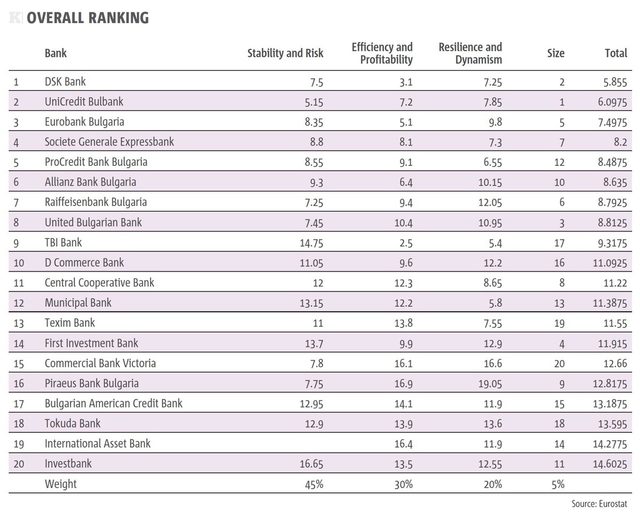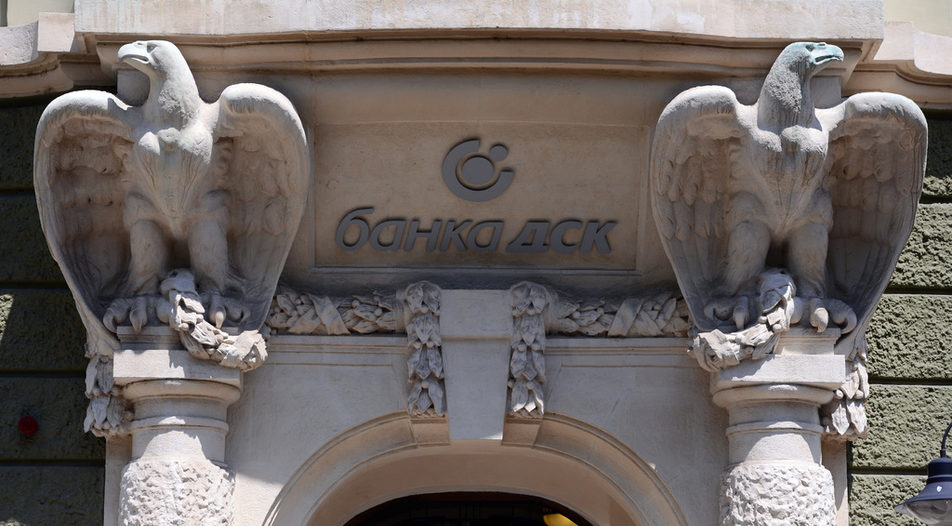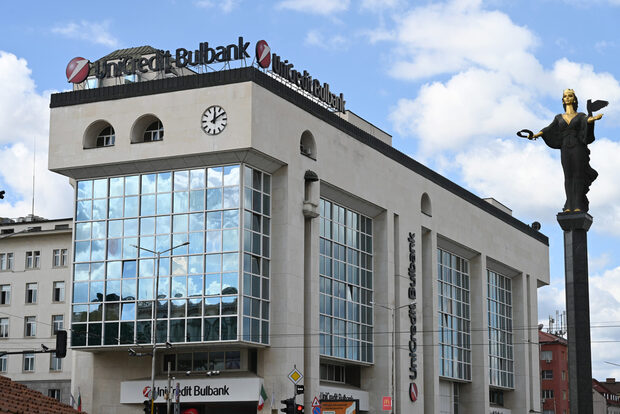This year's K10 ranking of the banks in Bulgaria compiled by Capital newspaper is more dynamic than usual. Even though the bigger picture hasn't changed much - the upper half is dominated by foreign-owned banks, whereas locally controlled lenders take positions in the rear, the year marked further consolidation of the banking sector, on record-setting merger deals.
Bankers react to the changes in the economic cycle in various ways, but the transfer of employees from one department to another is probably the best indicator to gauge their mood. With the onset of a crisis, departments of a bank once dealing in lending or risk management, shift their focus to special asset management, restructuring, work-out or whatever name that bank has decided to use when referring to bad loans.
Respectively, the start of an economic boom is usually accompanied by the reverse process, where efforts are once again focused on sales. Financial data and statements made by bankers in Bulgaria show that this is exactly what happened in 2017. The sector has managed to shake off the awful memories of 2014 when Corporate Commercial Bank collapsed and the panic surrounding First Investment Bank threatened the financial system with a massive bank run. In 2016, Bulgarian banks passed through the purgatory of asset quality reviews and stress tests. Even though the tests might not have solved all problems in the sector, they at least helped sketch them out well. Therefore, with the yard cleaned up, and with low rates and growth in the Eurozone lending support, banks in Bulgaria logically set their sights on the stars.
The good news is that, unlike the times of the credit boom of 2007, business growth now looks substantially more sustainable and moderate and it seems the bankers have learned their lessons from the hard experience of the past. Many banks are acutely aware that the next few years represent a window of opportunity, during which they need to position themselves for the next crisis. That process has many dimensions: from a purely tactical clearing of balances from non-performing loans, to strategic decisions about the degree to which banks need to be aggressive in their growth, and - for international groups - which markets to focus on and which ones to leave.
The Dynamic Ten
The composition of the Top 10 group remains largely unchanged, with a single addition - the small D Bank taking up the tenth place. This position, however, became vacant not because another bank had moved down the ranking but as a result of the merger of Cibank with United Bulgarian Bank (UBB) following the acquisition of UBB by Belgian financial group KBC.
In the wake of this transaction, UBB is now the third largest in terms of assets in the Bulgarian banking sector. The bank, however, also posted a large one-off loss due to impairments, which pushed it from 4th place in the previous year's ranking, down to the 8th position this year. The biggest leap forward - up five positions to 3rd place, is achieved by Postbank as a result of its aggressive growth in lending and its substantially improved performance and profitability indicators.
There is a change at the top as well: after spending two years as a runner-up, DSK Bank now returns to the leading position without being top-ranked in any of the sub-rankings but through maintaining a stable position among the top 5 in all of them. Unicredit Bulbank, which previously held the first place in K10 and is the largest by assets in the country, drops one position but retains its first place in the "Stability and risk" category.
The small TBI Bank, whose business model is focused on higher-risk consumer lending, wins the prize in the categories "Efficiency", "Profitability" and "Sustainability and dynamics". Its operations are marked by substantially higher margins compared to any other bank in the market but its expensive deposit financing drags it down in terms of its risk indicators. As a result, this puts it in 9th position in the overall ranking.
Hidden Record
Banks reported a profit of 1.17 billion levs in 2017, down 7% over the prior year when they received a one-off bonus as a result of the transaction in which Visa Inc. bought out Visa Europe from a number of European banks. The Bulgarian banks participating in the payment system of the card giant received a total of 186 million levs from the transaction. Without the effect of this injection, real profit growth of Bulgarian banks in 2017 ammounts to about 9%.
This increase takes place despite the year-on-year decline of net interest income by about 140 million levs. The reason is that deposit interest rates reached their bottom-line around zero towards the end of 2016, while loan interest rates were still higher and continued to decline until the end of 2017. The fall in lending rates was somewhat offset by the 75 million levs increase in income from fees and commissions, itself largely resulting from new lending where each new loan is accompanied by one-off fees, as well as increased economic activity that generates more payments and transfers. Over the course of the year, banks also reported 70 million levs less in impairment costs.
After these two years of record achievements, though, the bank financial results in 2018 will fall under pressure on more than one front. First of all, the excess liquidity of banks exacerbates competition not only for new credit sales, but also for refinancing at more favorable terms. This factor has kept the trend towards squeezing margins in place for the first months of the new year. Furthermore, banks are implementing a wide range of new regulations over the course of this year. Aside from the direct costs related to the implementation of some of those regulations, they will also have a direct impact on accounting reports. For example, the new International Accounting Standard 9 provides for setting aside provisions for loans that are being serviced which could have a direct impact on profits. The new rules pertaining to large exposures and connected parties may also lead to additional costs for some banks.
To top it all off, banks will have to make slightly higher contributions towards the Deposit Insurance Fund and the Bank Restructuring Fund this year. The negative interest rate on their excess reserves with the Bulgarian National Bank is also higher, with the central bank having increased it from -0.4% to -0.6% last September, which is estimated to add around 10 million levs in costs. Furthermore, the general trend of wage increases in the country may put administrative costs of banks under pressure and it is unclear whether this can be offset through other means of improving efficiency. Ongoing or potential mergers are in all probability also set to generate additional one-off costs for separate banks before they would be able to achieve any economies of scale.
The declining depreciation costs, a direct result of the ongoing economic growth, are likely to have a positive impact on the bank's bottom line. The overall good business climate shrinks to the minimum the generation of new loan defaults, while the growth of property prices allows for the sale of collaterals accumulated over the years. This mix, however, does not hold potential for new profit growth, and even sustaining the profit at the reported levels of over 1 billion levs will be a success in this challenging environment.
Customers' Market
The combination of increasing competition, excess liquidity and penetration of fintech companies places increased emphasis on the customer. In their struggle to win customers, banks are increasingly forced to digitize and deploy online and mobile services. At the same time, unlike their smaller, more flexible and unregulated competitors, they are unable to shed their branch network. The customers who rely on banking physically at the branches are still a majority, but those who would replace going to the bank with a more convenient banking application on their mobile phone are increasing in numbers.
This environment is favorable to the customer. The fight for customers, however, hides risks before the times of negative interest rates are over. There are significant worries in the Eurozone and in all other regions where negative interest rates are being applied that risk assessment borders on the impossible in these conditions and a reversal in this trend with an increase in rates might sink a large number of companies and projects.
If the previous credit boom could be regarded as a textbook example, indicators now look much more moderate and bankers themselves sound much more realistic in terms of their expectations and their lending appetites. The following pages of K10 will give you a review of the numbers, as well as a breakdown on how key names in the sector read them.

Methodology
Banks are ranked based on a number of indicators divided into four groups: stability and risk, efficiency and cost-effectiveness, sustainability and dynamics, and size. Each indicator has a different weight which is defined based on consultations with bank experts and reflects its relevance, as well as the extent to which it is subject to distortions due to one-off effects or accounting policies in practice. We have deliberately attempted to refrain from giving substantial weight to indicators related to the size of the bank (assets, deposits, loans), or to ones in relation to which regulatory or marketing reasons may lead banks to beautify the actual numbers (bad loans, net profit, equity ratios).The same methodology applies to bank branches. However, since they do not have any separate capital, part of the indicators (namely ROE, capital adequacy, asset-to-capital) have not been included and the weight ratios applied are respectively slightly different. In addition, they have not undergone asset quality reviews or stress tests, so the indicators related to those checks can not be taken into account.
For the purpose of calculation of the indicators, the financial data of the United Bulgarian Bank and Cibank, which merged into it at the beginning of 2018, has been added up. Even though formally the two banks concluded last year as separate institutions, the deal was announced at the end of 2016 and was finalized in mid-2017.
For the full methodology, please refer to K10 The best banks in Bulgaria.
This year's K10 ranking of the banks in Bulgaria compiled by Capital newspaper is more dynamic than usual. Even though the bigger picture hasn't changed much - the upper half is dominated by foreign-owned banks, whereas locally controlled lenders take positions in the rear, the year marked further consolidation of the banking sector, on record-setting merger deals.
Bankers react to the changes in the economic cycle in various ways, but the transfer of employees from one department to another is probably the best indicator to gauge their mood. With the onset of a crisis, departments of a bank once dealing in lending or risk management, shift their focus to special asset management, restructuring, work-out or whatever name that bank has decided to use when referring to bad loans.










